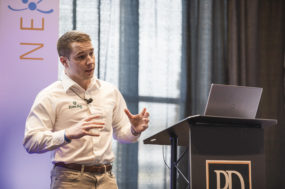Most dairy producers would agree that the adoption and use of technology increases operational efficiencies and, in return, lowers the cost of producing milk. Clear examples include the move from stanchion barns to freestall facilities and milking parlors in an effort to increase labor efficiency, the use of artificial insemination to facilitate greater genetic advancement within a herd, as well as the use of hormone therapy to get cows pregnant earlier in their lactation to reduce total days in milk, which allows for more lifetime milk production. More recent technological advancements include rbST, synthetic feed additives and gender-sorted semen. While some dairy producers find these more recent technologies to be controversial and “bad for the industry,” I find them to be tremendous tools that help lower my cost of production, making my dairy business more profitable.
One excellent example of how technology has made my dairy business more profitable is rbST. Since September of last year when I implemented its use, the herd average milk production has increased nearly 18 percent. (Data collected from test day averages from August 2010 to March 2011.)
This has contributed to a significant reduction in the operation’s cost of producing milk. As with any increase in production, this helped my bottom line by diluting fixed costs. There are very few costs on a dairy farm that are truly variable; increases in production, especially production per cow, will almost always improve the profitability of a dairy operation.
Some would argue that costs such as labor, veterinarian services, medicine, livestock supplies, utilities and feed are always variable and will increase proportionally as milk production increases. This is not true. Since I started using rbST*, these expenses, with the exception of feed, have not changed. The respective cost per hundredweight of these items has actually gone down.
As I look at ways to increase milk production, feed cost remains a major factor. Feed costs go down per hundredweight as milk production increases. The feed conversion rate on my dairy used to be a little less than 1.6 pounds of milk per dry matter pound of feed. Now, that same ratio normally runs around 1.8 pounds of milk per pound of feed.
This change in efficiency shows that all feed costs are not truly variable because a cow needs the same amount of nutrients for maintenance whether she is dry or making 100 pounds of milk per day. With the maintenance cost fixed, as dry matter intakes increase, maintenance shrinks as a percentage of total feed cost. So the cost of maintenance is diluted. This results in a lower feed cost per hundredweight.
Last August the cost of feeding a cow on my operation was $5.44 per day (this price includes a fair market assessment on the forage in the ration, since it was grown by the dairy operation). At the time, we were producing 82 pounds of milk per cow per day, which resulted in a per-hundredweight cost of $6.63.
By March of this year, with no significant changes to the ration and using the same prices for forages and concentrates (as to eliminate market changes from affecting the example), the feed cost per cow per day had increased to $5.75 because dry matter intakes had increased. Although the cost of feeding a single cow increased, the increases in production per cow resulted in a per-hundredweight cost of $5.92.
This simple example shows that diluting the fixed maintenance cost of feeding a dairy cow by increasing her dry matter through the use of technologies can lead to major reductions in the cost of producing milk.
It goes without saying that there is no “silver bullet” for enabling dairy cows to express their genetic potential. Tools such as rbST, sexed semen, synch programs, etc., are only one piece of the puzzle. A former teacher of mine was the first to tell me, “You can’t make a silk purse out of a sow’s ear.” Although he was not referring to dairy production, his comment fits the topic at hand – there is no substitute for such things as high-quality forage, cow comfort and sound management.
The better a cow’s needs are tended to, the better she will respond to technologies. By sharing my experiences, I give no guarantee that you will see the same results on your operation; however, I will testify that the results I got from rbST have encouraged me to explore even more technologies that will increase the profitability and milk production per cow of my operation. PD
*The label contains complete use information, including cautions and warnings. Always read, understand, and follow the label and use directions. Supplement lactating dairy cows every 14 days beginning at 57-70 days in milk until the end of lactation.
Dustin Bliss
Owner of DT Farms
Cedar City, Utah
dt-enter@live.com





